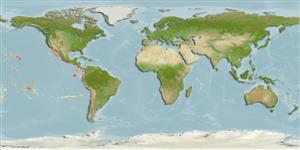Elasmobranquios (tiburones y rayas) (sharks and rays) >
Squaliformes (Sleeper and dogfish sharks) >
Etmopteridae (Lantern sharks)
Etymology: Centroscyllium: Greek, kentron = sting + Greek, skylla = a kind of shark (Ref. 45335).
More on author: Garman.
Environment: milieu / climate zone / depth range / distribution range
Ecología
marino bentopelágico; rango de profundidad 269 - 1170 m (Ref. 96339). Deep-water; 32°N - 30°S
Eastern Pacific: Hawaiian Islands, southern California (USA), Panama, Cocos Island (Costa Rica), Colombia, Ecuador, northern and central Chile, and the Galapagos Islands. Has been confused with Etmopterus granulosus (Günther, 1880) and Centroscyllium granulatum (Günther, 1887), but is quite distinct.
Tamaño / Peso / Age
Maturity: Lm ? range ? - ? cm
Max length : 51.0 cm TL macho / no sexado; (Ref. 96339)
A little-known deepwater dogfish found on the continental and insular slopes. Incidentally caught in sablefish (Anoplopoma) traps but not utilized. Feeds chiefly on other fishes and invertebrates (Ref. 28023). Ovoviviparous (Ref. 205).
Life cycle and mating behavior
Madurez | Reproducción | Puesta | Huevos | Fecundidad | Larva
Distinct pairing with embrace (Ref. 205).
Compagno, L.J.V., 1984. FAO Species Catalogue. Vol. 4. Sharks of the world. An annotated and illustrated catalogue of shark species known to date. Part 1 - Hexanchiformes to Lamniformes. FAO Fish. Synop. 125(4/1):1-249. Rome, FAO. (Ref. 247)
IUCN Red List Status (Ref. 130435)
Threat to humans
Harmless
Human uses
Pesquerías: sin interés
Más información
ReferenciasAcuiculturaPerfil de acuiculturaRazasGenéticaElectrophoresesheritabilidadEnfermedadesProcesamientoNutrientsMass conversion
ColaboradoresImágenesStamps, Coins Misc.SonidosCiguateraVelocidadTipo de nataciónSuperficie branquialOtolitosCerebrosVisión
Herramientas
Special reports
Download XML
Fuentes de Internet
Estimates based on models
Preferred temperature (Ref.
123201): 6.6 - 9.9, mean 8 °C (based on 44 cells).
Phylogenetic diversity index (Ref.
82804): PD
50 = 0.5078 [Uniqueness, from 0.5 = low to 2.0 = high].
Bayesian length-weight: a=0.00372 (0.00188 - 0.00734), b=3.10 (2.92 - 3.28), in cm total length, based on LWR estimates for this (Sub)family-body shape (Ref.
93245).
Nivel trófico (Ref.
69278): 3.9 ±0.56 se; based on food items.
Resiliencia (Ref.
120179): Bajo, población duplicada en un tiempo mínimo de 4.5-14 años (Fec assumed to be <100).
Fishing Vulnerability (Ref.
59153): Moderate vulnerability (40 of 100).
Nutrients (Ref.
124155): Calcium = 6.46 [1.11, 35.03] mg/100g; Iron = 0.217 [0.049, 0.765] mg/100g; Protein = 17.3 [15.0, 20.0] %; Omega3 = 0.292 [0.094, 0.949] g/100g; Selenium = 15.5 [3.7, 55.0] μg/100g; VitaminA = 23.9 [3.9, 143.4] μg/100g; Zinc = 0.503 [0.225, 1.077] mg/100g (wet weight);
